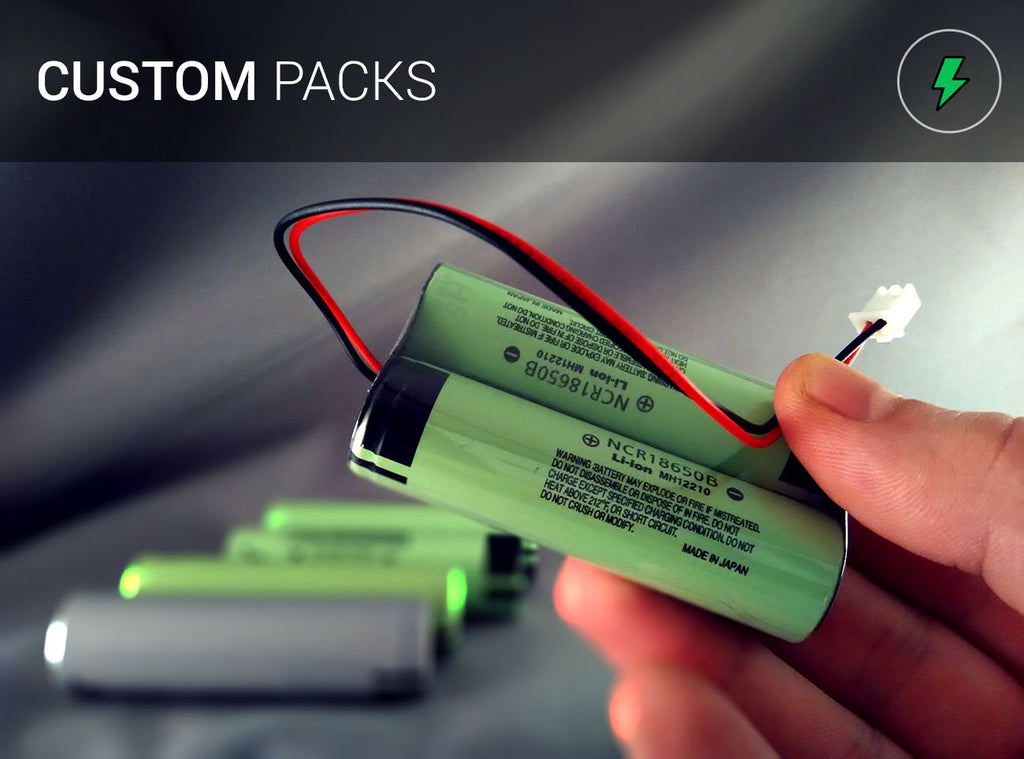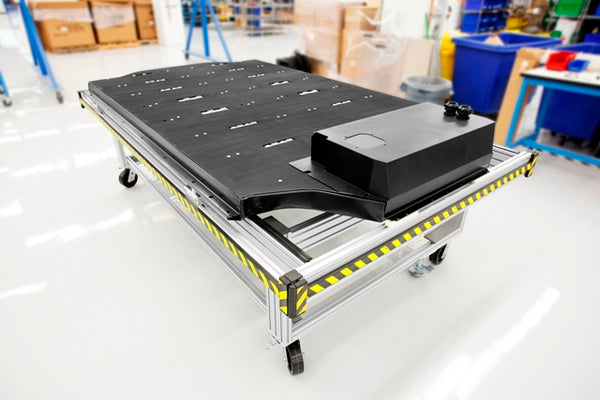Let's Build an 18650 Battery Pack

An 18650 battery pack Battery Bro built out of high-capacity Panasonic NCR 18650B cells, in a C format configuration.
Are you interested in building custom battery packs? This page is all about that - particularly the 18650 battery pack. Here we go into detail describing the process we use to create custom battery packs.
Or, our expert team can do all the heavy lifting for you.
If you would like Battery Bro to manufacturer your custom battery packs the best way to proceed is to fill out the following Google Form to the best of your ability.
We will contact you within 2-3 business days after reviewing your submission.
Notice: 10.24.2020
As of today, all our custom battery packs will route through our sister company Voltaplex Energy. For all battery pack requests please visit Voltaplex.com. Thank you!
Visit https://voltaplex.com
If you have any questions you can send us a message and we will happily give you our expert advice.
How we build the best custom battery packs
Table of Contents
- Defining your pack
- Configuration
- Price
- Get a sample
- Production
- QC & Support
Step 1. Defining your goals explicitly (with a spec sheet) leads to great things
Your 18650 battery pack build should begin after you answer these preliminary questions for yourself. They will help you focus your mind on the important aspects of rechargeable battery pack design.
- If the pack is commercial, who is your end-user?
- What are the three most important factors for your custom battery pack to succeed?
- What is your biggest worry concerning your battery pack project?
- What are the most extreme environments your pack will go through? (Temperature, dirt, water, radiation, vibrations, etc.)
What do you already know about your project? Below is a list of specifications that should be determined for your 18650 battery pack.
Columns are added for minimum and maximum specification if necessary, but are not required.
Priority column should reflect the importance of adhering to a particular specification. Priority 1, being the highest denotes a critical adherence. Priority 5 on the other hand means it is not important at all (for example, no special requirements).
If you're building custom battery packs, you'd better take a minute listing as many of the following specifications as you can.
|
Specification |
Norm. |
Min. |
Max. |
Priority 1-5 (1 highest) |
Notes |
|
A (ampere) output |
|||||
|
mAh (milliamp hour) output |
|||||
|
V (Voltage) output |
|||||
|
W (watt) output |
|||||
|
Total cost |
|||||
|
Charging time |
|||||
|
Weight |
|||||
|
Safety |
|||||
|
Form factor |
|||||
|
Special requirements |
Here is a link to a Google Forms template you can use.
Glossary
A (amperage) output - this is the total current your 18650 battery pack will be able to provide. It measures the amount of electricity used. Amps multiplied by volts is equal to wattage.
mAh (milliamp hour) output - this is the total capacity of your battery measured in milliamp hours, which are a 1000th of an amp hour (Ah). Either measure can be used. The higher the mAh, the longer your battery will last before it needs to be recharged.
V (Voltage) output - Volts are a measure of electric potential energy and represent the amount of energy that could be released if current is allowed to flow. The relationship between voltage and current is defined by Ohm’s Law.
W (watt) output - Watts are another measure of electric power; watts depends on amps and volts (watts are equal to Volts multiplied by amps). The watt unit is defined as joule per second.
Cost - The total cost of the battery pack should be what you find desirable, not what you expect Battery Bro to provide. If you are not certain what a realistic final price will be, feel free to leave the fields blank.
Charging time - Charging times can be important depending on the application of your custom battery. Keep the end-user in mind - how much friction will it cause for each additional hour of charging time? Take some time to come up with normal and maximum values.
Weight - 18650 Battery packs are already designed to be as light as possible while remaining durable. If your project has special weight requirements that require special solutions please make note of them.
Safety - Safety is critical and packs are always designed to adhere to safety standards set forth by organizations like the UN. In some projects, especially those involving medicine and children more safety precautions are needed so it is important to make note of special safety considerations.
Form factor - The shape and dimensions of your 18650 battery pack build are likely determined by their enclosure in your particular application. Every project is unique and it’s important to have the specs measured well the first time.
Special requirements - Do you need a special box to prevent corrosion from salt spray? Or temperature control in very cold or hot environment? What is special about your project and the battery’s environment that will add additional systems to the custom batteries?
Case Study: Battery Bro and The Impossible

Battery Bro and Impossible Ebike worked together to come up with the right lithium-ion cell and battery pack combination for their exciting new project. The Impossible bike raised over $300,000 on Kickstarter with the vision of creating a commuter electric bike that can fit in a bag.

The custom 18650 battery pack for the Impossible had a few unique challenges like:
- Adequately protecting batteries in the wheel against vibration and puncture.
- Understanding the effect of spinning li-ion batteries.
- Maximizing capacity in a small space.
- Keeping costs as low as possible.
To learn more about how tackled these problems, read on for Step 2.
Step 2. Problem solving and the configuration
Once we fletch out a specification sheet for your liion battery pack we can move on to the next step which deals with the following design and more technical points:
- Configuration
- Cell choice
- Form factor
- BMS (battery management system)
- Smart charger
- Special requirements
Glossary
Configuration - The configuration of the battery pack includes both the cell count and how they are arranged either in a series or in parallel, or in a combination of both configurations.
General types:
- Serial - Increases voltage
- Parallel - Increases capacity
- Serial / Parallel - A combination of both
Deciding which of these three general configuration types is determined by the required specifications outlined before, in particular voltage and capacity requirements. A 12v 18650 battery pack build is very common.
Common battery pack configuration formats:
- B Format - end to end
- C Format - side by side
- BC Format - a combination of B and C formats
- Standard - Side by side interlinked with solder tags
- Cluster Format - Polygon shape interlinked with solder tags
- Nest Format - Staggered interlinked with solder tags
Deciding between 18650 battery pack formats is determined by what general type battery pack you need and other restraints set by your specification sheet, especially form factor. Some formats conserve space like the nested format. Others, like the standard of cluster format are better a dissipating heat.
Cell choice - By combining the specs we listed above in step one, we can determine the best cell choice for your pack. Usually we provide two or three choices corresponding to different performance options and costs. At this time, our choice for lithium battery manufacturer is either LG, Samsung, or Panasonic.
- Typically we use Panasonic cells for battery packs for ebikes, electric vehicles, and other applications which require a high capacity.
- We use LG and Samsung cells typically for applications which require a high max. continuous discharge current (high amperage output).
- It is important to always use the same cells (a pack is only as strong as its weakest cell).
- It’s important to match Rank A and Rank B cells together when building an 18650 battery pack.
BMS (battery management system) - The BMS for custom battery packs is a PCB (printed circuit board) that manages the battery pack to keep the whole pack system in its safe operating area. The BMS can also be used to automate and optimize processes within the system, improving custom lithium battery pack performance. Management can include the following features:
- Monitoring & Recording
- Voltage, Temperature, SOC, SOH, coolant flow, current, etc.
- Stored in memory
- Protection
- Over-current, under-voltage, temperature, pressure, short-circuiting, etc.
- Ability to control environment in feedback with monitors
- Energy Recovery (for electric vehicles eg. regenerative braking)
- Computation & Metrics
- CCL, DCL, Coulomb counter, cycle-life, total energy since first use
- Communication
- Serial, direct, BUS
- Wireless like bluetooth, audio codes, etc.
- Load Balancing
- Balancing charge & discharge across each cell
- Modular charging, or shuffling energy
Most BMS systems are well standardized and do not need customization. A BMS circuitry can be chosen based on voltage and features required by the specification sheet drawn up earlier. A unique BMS is not required for applications in developed industries like custom battery packs for e-bikes, LED lighting system, power-tools, and so forth.
BMS and can be purchased from a reputable manufacturer like Texas Instruments.
Smart charger - How do you make a charger smart? You put a microchip in it and establish communications between it and the BMS (battery management system). This gives the BMS one more area of control for which it can improve safety and performance.
- Smart Battery Systems (SBS) are smart chargers with a defined SMBus connection and are used by laptops.
Special requirements - At this point of the custom lithium battery pack design, more special requirements may have come to light, especially concerning things like the BMS or configuration format. It’s important to make note of any new considerations that arise.

A laptop lithium-ion battery pack, which is typically in the configuration 3s2p.

The Tesla Model S lithium-ion battery pack compartmentalizes over 7,000 individual 18650 cells.
Step 3. Price of custom battery packs
The price to create custom rechargeable battery packs is dependent on many variables and is always custom quoted per project. Costs are determined by:
- Cell cost
- Special materials or components, unique features
- Quality control requirements
- Testing and certification
- Packing, shipping, customs
Step 4. Building sample 18650 battery pack
After your specification sheet is laid out, your technical specifications are settled, and you know exactly what it will cost to produce, a sample is created. Testing the sample is done in-house and is sent to your door wherever you are in the world.
Step 5. Iterate and full production
Samples and designs are iterated until the product is finalized. Production may begin any time after designs are finalized and pro forma invoice is signed,
Step 6. Quality control & after-sales support
On-going QC with custom terms and dedicated English-speaking support. Specialized quality control, UN certification, explosion, vibration, high-discharge tests, and more services are available at request.
